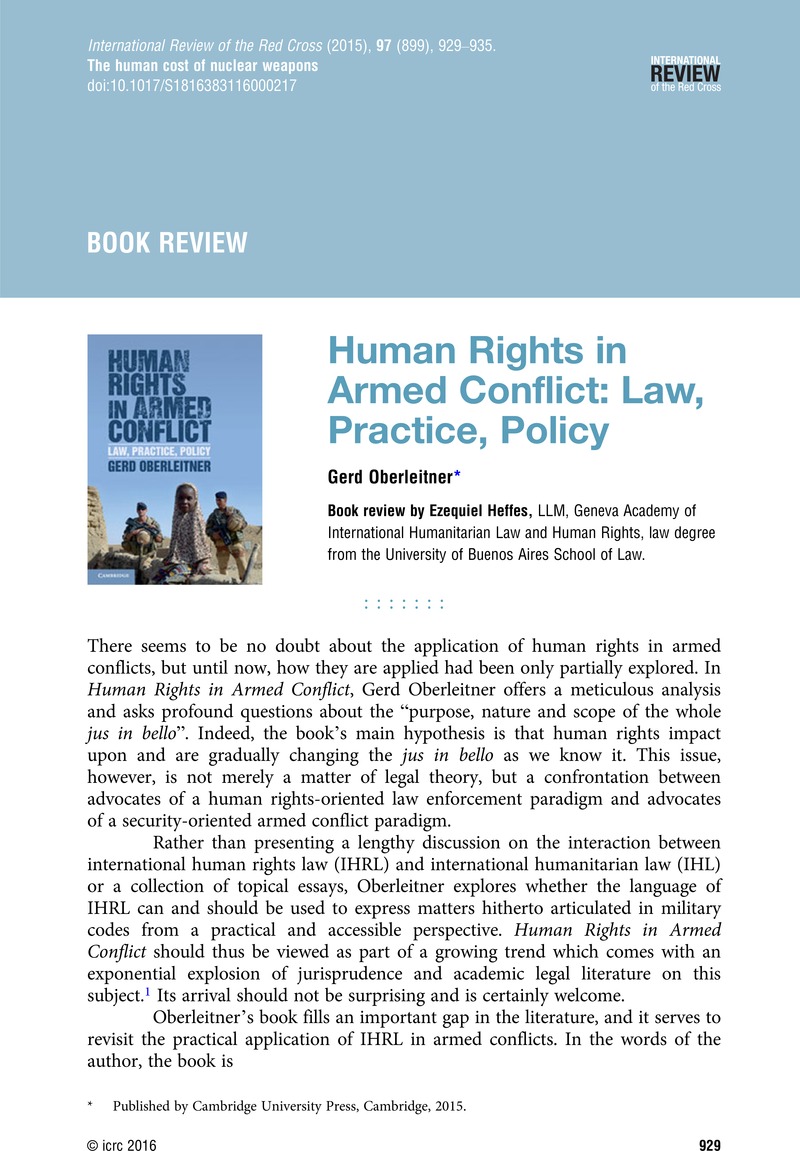No CrossRef data available.
Published online by Cambridge University Press: 16 May 2016

1 Within this vast body of literature, there are a few books that stand out: see, for instance, Orna Ben-Naftali (ed.), International Humanitarian Law and International Human Rights Law, Oxford University Press, Oxford, 2011; Robert Kolb and Gloria Gaggioli (eds), Research Handbook on Human Rights and Humanitarian Law, Edward Elgar, Cheltenham and Northampton, 2013.
2 Human Rights in Armed Conflict, p. 2.
3 Ibid., p. 6.
4 Ibid., p. 9.
5 Ibid., p. 34.
6 Ibid., p. 73. Recently the ICRC has restated its view confirming that “IHL constitutes the lex specialis governing the assessment of the lawfulness of the use of force against lawful targets in [international armed conflict]”. ICRC, International Humanitarian Law and the Challenges of Contemporary Armed Conflicts, Report, 31 October 2015, pp. 34–35, available at: www.icrc.org/en/document/international-humanitarian-law-and-challenges-contemporary-armed-conflicts (accessed on 18 November 2015).
7 Human Rights in Armed Conflict, p. 97.
8 Ibid., p. 342.
9 Ibid., p. 102.
10 International Convention against the Taking of Hostages, UN Doc. A/34/46, 1979. Regarding its application in non-international armed conflicts, a complementary analysis should be done with respect to Articles 12 and 13, leading to the conclusion that the Convention applies to cross-border non-international armed conflicts or when the hostages or alleged offenders are foreigners. See also Andrew Clapham, “The Complex Relationship between the Geneva Conventions and International Human Rights Law”, in Andrew Clapham, Paola Gaeta and Marco Sassòli (eds), The 1949 Geneva Conventions: A Commentary, Oxford University Press, Oxford, 2015, pp. 707–708.
11 Human Rights in Armed Conflict, p. 102.
12 Ibid.
13 Ibid., p. 122.
14 Ibid., p. 124.
15 Ibid., p. 126.
16 Ibid., p. 141.
17 Ibid., p. 165. It shall be noted that Oberleitner recognizes this despite the attempts by the United States to argue “that persons held in secret detention facilities outside” its territory were not under the jurisdiction of the United States as they were held in “places” rather than “territories”. He finally affirms in this sense that “there is nothing that puts an end to the ever-shrinking space over which jurisdiction can extend”. Ibid., p. 166.
18 Ibid.
19 Ibid., p. 167.
20 Ibid., p. 192.
21 Ibid., pp. 201–205.
22 According to different sources, the total number of armed conflicts in recent years fluctuates between thirty and thirty-eight, and only two or three of them are considered to be international. See Stuart Casey-Maslen (ed.), The War Report 2013, Oxford University Press, Oxford, 2014, pp. 28–29.
23 Human Rights in Armed Conflict, p. 213.
24 Ibid., p. 217.
25 Ibid.
26 Ibid.
27 Ibid., p. 349.
28 Ibid.
29 Ibid., p. 338. For recent studies addressing this issue, see Noemi Gal-Or, Cedric Ryngaert and Math Noortmann, Responsibilities of the Non-State Actor in Armed Conflict and the Market Place, Brill Nijhoff, Leiden and Boston, MA, 2015; Heffes, Ezequiel, “The Responsibility of Armed Opposition Groups for Violations of International Humanitarian Law: Challenging the State-Centric System of International Law”, Journal of International Humanitarian Legal Studies, Vol. 4, No. 1, 2013, pp. 81–107CrossRefGoogle Scholar.